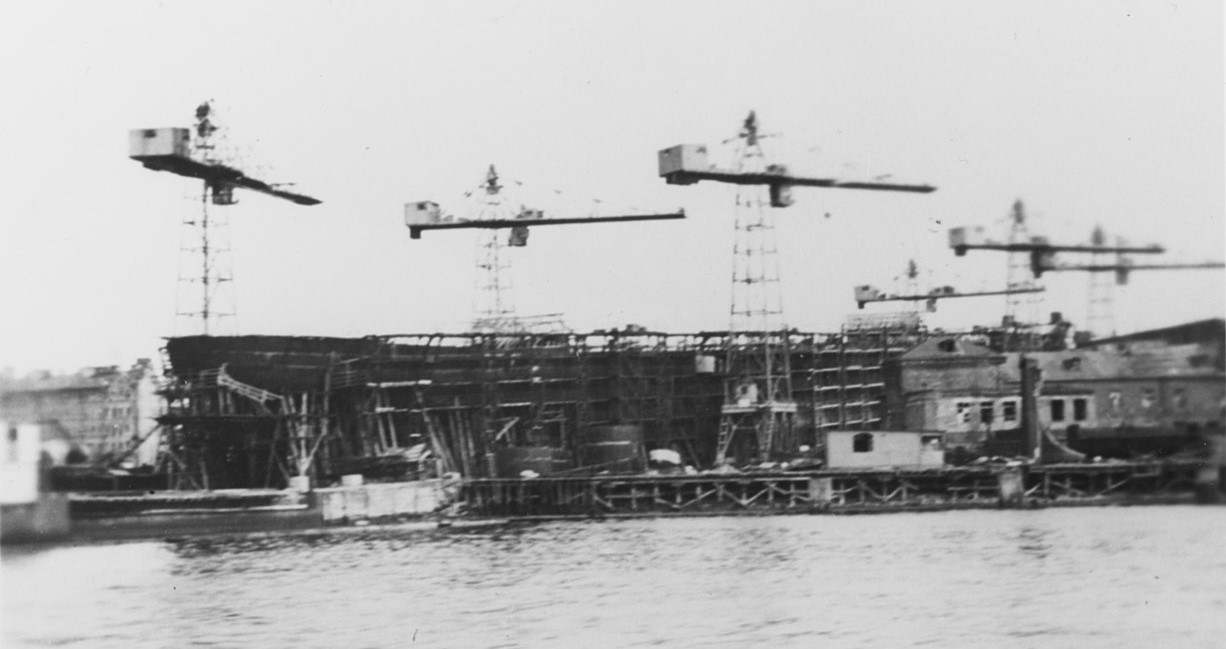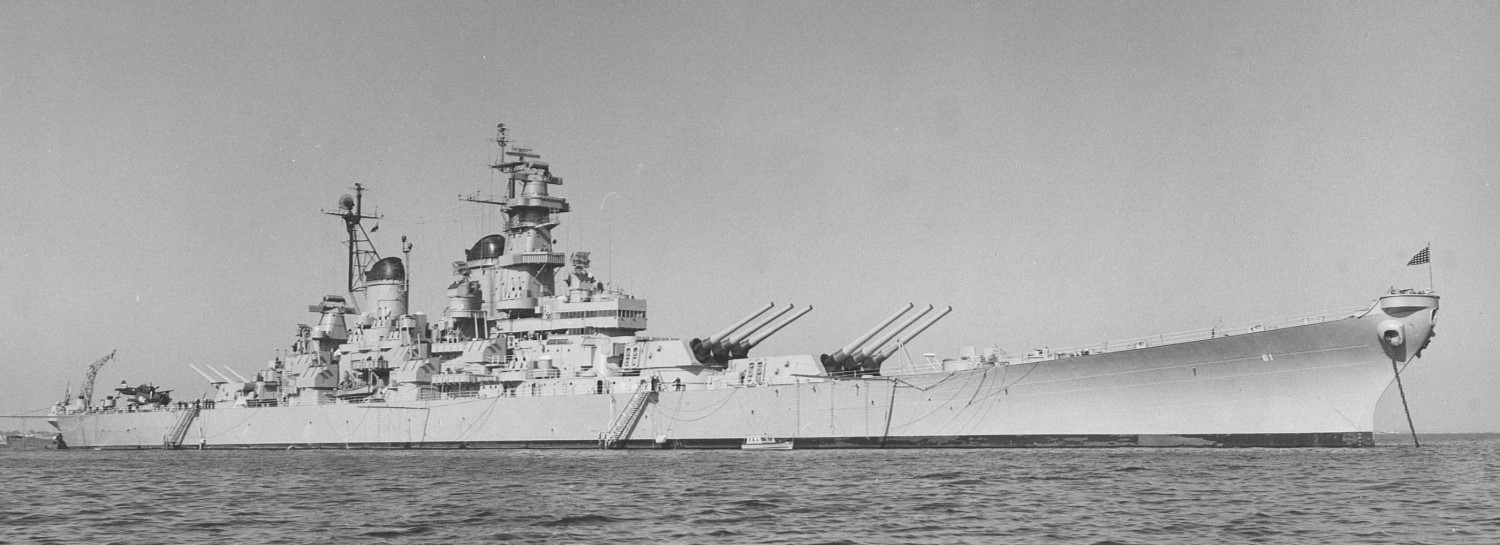When Joseph Stalin decided to build a navy in the 1930s, he planned to build it around battleships. The design process was hampered by lack of experience and by the purges ongoing in the Soviet union, and while the first of the four ships was officially laid down in 1938, it took another year to get the design finalized to the point that construction could begin. Even before the German invasion stopped construction, one ship was cancelled due to bad rivets, and the other three lagged massively.

The incomplete hull of Sovetskii Soiuz in 19441
But Stalin was already pushing for follow-up ships, and as the original dates for launching were very aggressive, the initial plan was to lay down the follow-on ships to an evolved variant of the Sovetskii Soiuz design. The major objectives were to raise speed from 28 kts to 30 kts, to replace the Puligese torpedo defense system with a more effective multibulkhead design, and to improve AA firepower, which was becoming increasingly important. The designers also worked to simplify the complicated armor scheme of the earlier design, which had used 19 separate thicknesses of armor plate.
Speed was to be the biggest challenge. Because of the need to produce a design rapidly, the new design, designated Project 23bis2 had to repeat the earlier vessel's machinery. Without more power, there were only two options: increasing length and fitting better propellers. The designers tried both, lengthening the ship on the waterline from 260m to 280m, and replacing the original propellers with bigger ones. They estimated that they would be able to meet the desired 30 kts, while a .7 m increase in beam allowed the twin 152mm AA mountings with triples. The belt was reduced from 420mm to 380mm, the reduced thickness compensated for by an increased slope. The idea of adding a fourth triple turret was briefly investigated, but the 74,000-ton result was too big and too slow.
The problems came when it was time for the initial sketch design to be handed over for detailed design work. In most navies, this was a reasonably smooth process, with the final design closely resembling what preliminary design produced. However, Stalinist design processes weren't up to this task, and the detailed designers at the Baltic Works produced a design that was 20m longer and 4,000 tons heavier than the preliminary sketches. It quickly became apparent that the result wasn't particularly practical, but the designers were saved by the production problems with the Sovetskii Soiuz class. The slipways wouldn't be free until 1943 at the earliest, which gave plenty of time for an all-new design, Project 24.

The threat - Iowa in the late 40s
The preliminary requirements for this design were issued in May 1941, and more or less matched what had been planned for the Project 23bis, with the addition of more planes and greater range, but a month later the Germans invaded, and work was disrupted when the design bureau was evacuated from Leningrad to Kazan. Some effort was made during the war years, although it was mostly on details like underwater protection. As the war wound down, a full spectrum of battleship studies was conducted, with an eye towards larger ships that could outmatch the Montana class, which the Soviets believed would form the basis of American battleship design postwar. In August 1945, plans were drawn for up to 10 75,000-ton ships over the period 1945-1955, although it soon became clear that further battleship construction outside Russia was unlikely, and the Navy dropped its request to four ships, subsequently cut to three by Stalin. One would be a unit of the Sovetskii Soiuz class, still incomplete, while the other two were slated to be laid down in 1955. This gave Soviet designers plenty of time to try to come up with a ship capable of countering the exaggerated rumors of the Iowas they had heard, which credited the ships with 19" belts and 35 kts.3 This often meant ships of 80,000-100,000 tons, but by late 1950, long after the battleship had been abandoned elsewhere, a decision was made to limit it to a "medium battleship" of only 73,000 tons.

Stalin in 1949
Even this was still seen as too large and criticized as "suitable for a battleship of the Second World War but not responsive to recent developments", so many pushed for a ship around the size of the contemporary Project 82 battlecruiser,4 three of which were actually laid down in the early 50s. The result was perhaps the last original concept for a gun-armed capital ship, with the idea being that several of these smaller ships could combine to take on a single larger dreadnought. Each would be armed with 2-5 heavy guns, 406-mm or even 457-mm, supplemented by smaller guns of 180-mm and 220-mm firing HE shells to disable radar and fire-control equipment. In many ways, this hearkened back to the QF guns of the Pre-Dreadnoughts, designed for similar purposes. An adequate immune zone against 16" guns would be provided by sacrificing underwater protection and assuming that the ships would not fight directly on the beam, increasing the effective protection of the belts. More weight savings came from delegating the job of heavy AA firepower to the escorts, leaving the battleship with only short-range automatic AA weapons. On the whole, this was an interesting and intelligent response to the needs of the Soviet navy in the early 50s, and it led to the abandonment of the "medium" designs, although by the time the ships were completed, they would have been thoroughly obsolete. In the end, Stalin's death in March 1953 brought work on big-gun ships to a halt, and the long history of battleship design was over.
1 There are no pictures of any of the ships discussed here, because they were never finished. So I must improvise. ⇑
2 The Sovetskii Soiuz was Project 23. Bis is from Latin for "second time", and is used by the Russians for an improved design. ⇑
3 Interestingly, misconceptions about the Iowa armor scheme were common until the mid-70s. Siegfried Breyer's otherwise excellent Battleships and Battlecruisers 1905-1970 credits them with a 13.8" external, vertical belt. The earliest reference I can find to the correct scheme is in Dulin and Garzke's US Battleships from 1976. ⇑
4 I do intend to talk about these ships at some point, although it's going to take a while to get my hands on the appropriate materials. ⇑

Comments
The Montanas weren't cancelled until 1943, and Musashi wasn't sunk until 1944, so it doesn't seem unreasonable for an aspirational global superpower to be planning ships of this general type in 1941. The Soviet Union had the general industrial capacity for the job, though lacking some specifics like rolling mills for the plate, and unlike Japan they could fuel them from domestic production.
But in 1945, this seems like a pure Joseph Stalin vanity project. Was there anyone in the actual Soviet Navy who thought these ships were a good idea past 1944?
I'm sure there were lots of people who thought they were a good idea after 1944. After all, Stalin wanted them, and opposing him was usually not very healthy.
More seriously, I don't have a good understanding of exactly how much they knew and when. I've made the case that the battleship wasn't really obsolete until the mid-50s, and the Soviets were the only people who might be doing naval power in that era who didn't already have plenty of battleships sitting around. Would have been obsolete by the time they actually made it to sea, but that's a different issue. Beyond that, if you're not getting good reports of what's going on the Pacific and everything is filtered through the paranoia of the Soviet system, then battleships might make sense (outside of placating Stalin) into the late 40s.
Also, if you're the Soviets looking at defending the maritime flanks of your country against the Imperialist Capitalist Running Dogs in or around the North Atlantic, or in restricted waters like the Baltic or Black Sea where you can expect shore-based air support, surface engagements make some sense.
Does a blue water navy make any sense at for Russia, without control of Constantinople and Copenhagen? You only have two coastal industrial regions, and they are both prisons.
The ability to disrupt NATO use of the Atlantic (and US use of the Pacific) had some value. The ability to hunt US (and later British and French) SSBNs in the Arctic had extreme value, as does the ability to deploy your own SSBNs into the Atlantic. They didn't need a full-on sea control navy for that, but they definitely needed to be able to operate far beyond their own littorals.
... as did the ability...
So what the Soviet's really needed was less of a Blue Water Navy than a White Water Navy.
And, I'm going to make a wild guess, that the Arctic has even worse flying conditions than the rest of the oceans and so it takes even more years before a carrier force was reliable compared to a gun platform.
misconceptions about the Iowa armor scheme were common until the mid-70s Just an ordinary error, or the USN intelligence agencies deliberately muddying the waters?
If slipping a few wrong numbers into some reference books can get your enemies to spend a fortune trying to match a mythical specification that is actually beyond current tech... that's actually a very good return on your effort.
White water navy isn't a bad way of putting it. I'd use green water navy (from the standard term for water getting over the decks) but that has another meaning. And you're probably right about the need for battleships persisting longer, too, although I'm not sure that the Soviet Navy had the strategic thought to make that call, and I'm very sure Stalin didn't.
Finding out why people thought that way is on my list of things to do someday when I can dig through archives and such. I simply don't know what was going on, because the reports on the SoDaks are pretty accurate.
A book I read a long, long time ago (like, six years? So it's possible I'm misremembering it, caveat up front) called The Sea in Soviet Strategy argued that the Russians historically only really care about building a Blue Water Navy (hereinafter, BWN) when they are fairly powerful and secure on land already.
I will also note that once SSBNs become a thing, the Soviets building a BWN made a lot of sense (in the sense that the BWN existed to protect SSBN bastions).
@Blackshoe, BWN is not a useful acronym seeing as the terms usually being distinguished are Blue Water Navy and Brown Water Navy. It does help with the GWN and the WWN however.
Doctorpat:
Provided you don't believe your own propaganda.
The Soviets did build HEAT anti-ship missiles, which plausibly might be more effective against external armor than internal, but I don't know if this was related to what they thought the Iowas had.
Doctorpat: This has sort of become two conversations about different time periods - once SSBNs exist, so do attack SSNs, without the weather limitations of carriers.
Anonymous: What do you mean by that? Keeping the Iowas around for so long? At a guess, such a super-Iowa wouldn't stay worthwhile much longer than a real one, as she'd still lose to guided weapons.
@muddywaters: The HEAT warheads on the big Soviet antiship missiles were I believe optimized against the armored flight decks of the Midway- and Forrestal-class carriers. This was before sea-skimming missiles, so they would have been diving at a substantial (~30 degrees IIRC) angle, more likely to hit the deck than any belt.
Not sure whether they had enough excess capacity to penetrate the main armored deck of the Iowas, which would have had a substantial standoff from the (armored but less so) weather deck. That would not have been a primary design requirement, though.
I'm with John on this. The Soviets would have had no reason to build a missile specced against the Iowas. Their navy appears to have been built entirely around protecting them from nuclear attack, and the Mk 23 didn't have the range to worry them. So the Iowas had no strategic role until the 80s, at which time they were joining a vast pool of other ships flooding their ocean surveillance system. Also, if for some reason you need to kill a battleship, the nuclear-tipped anti-ship missiles will do fine.
Was going to note that if you really want to deal with battleship armor, nuclear ASCMs (and IIRC most of their missiles after the Termit and torpedos were assumed to be at least nuclear-capable) are a pretty good solution.
But what if you need to deal with a battleship but aren't willing to play a friendly game of Global Thermonuclear War?
There are lots of options there. Bombs, lots of missiles, torpedoes, or just not worrying too much about it. Soviet/Russian naval doctrine has always been essentially defensive, dating back at least to the Crimean War. By the 50s, the battleships were a minor threat compared to the carriers, because they couldn't fire more than 20 miles inland. And there were coastal guns in case they did get that close. Also, an unescorted battleship is pretty easy pickings, and none of the escorts had battleship-grade armor, so missiles could take them out.
The impression I got (from this site) was that your missiles would mission-kill them anyway, even if the armoured box stayed floating.
I'd give a battleship the best odds of not being mission killed by one of those missiles, but that doesn't mean it's invincible. Enough missiles, and you will get a mission kill, even if the ship is still floating.
This has some speculation on that, along with the one time similar missiles were actually fired at an Iowa (one crashed and the other missed, from close enough that she could shoot back, though accounts differ on whether she actually did that or a plane got there first).
It also looks possible to target a battleship's weak spots - acoustic homing torpedo to the propellers/shafts, or anti-radiation missile to the directors.
I also agree that at that time, heavily armored ships were sufficiently on their way out that it would be reasonable to not particularly care, and that nuclear weapons were probably considered more of an option than they are now.
On the Stalingrads. Including Stalin suggesting that they would panic enemy cruisers (!) or secure the Bosporus (!).
I like WWII after WWII. It would be nice if they didn't get basic details of battlecruiser history wrong, like not being intended to fight battleships.
Beyond that, it looks to be largely stuff I didn't have access to when writing this post, but now do, thanks to spending slightly too much on old volumes of Warship.